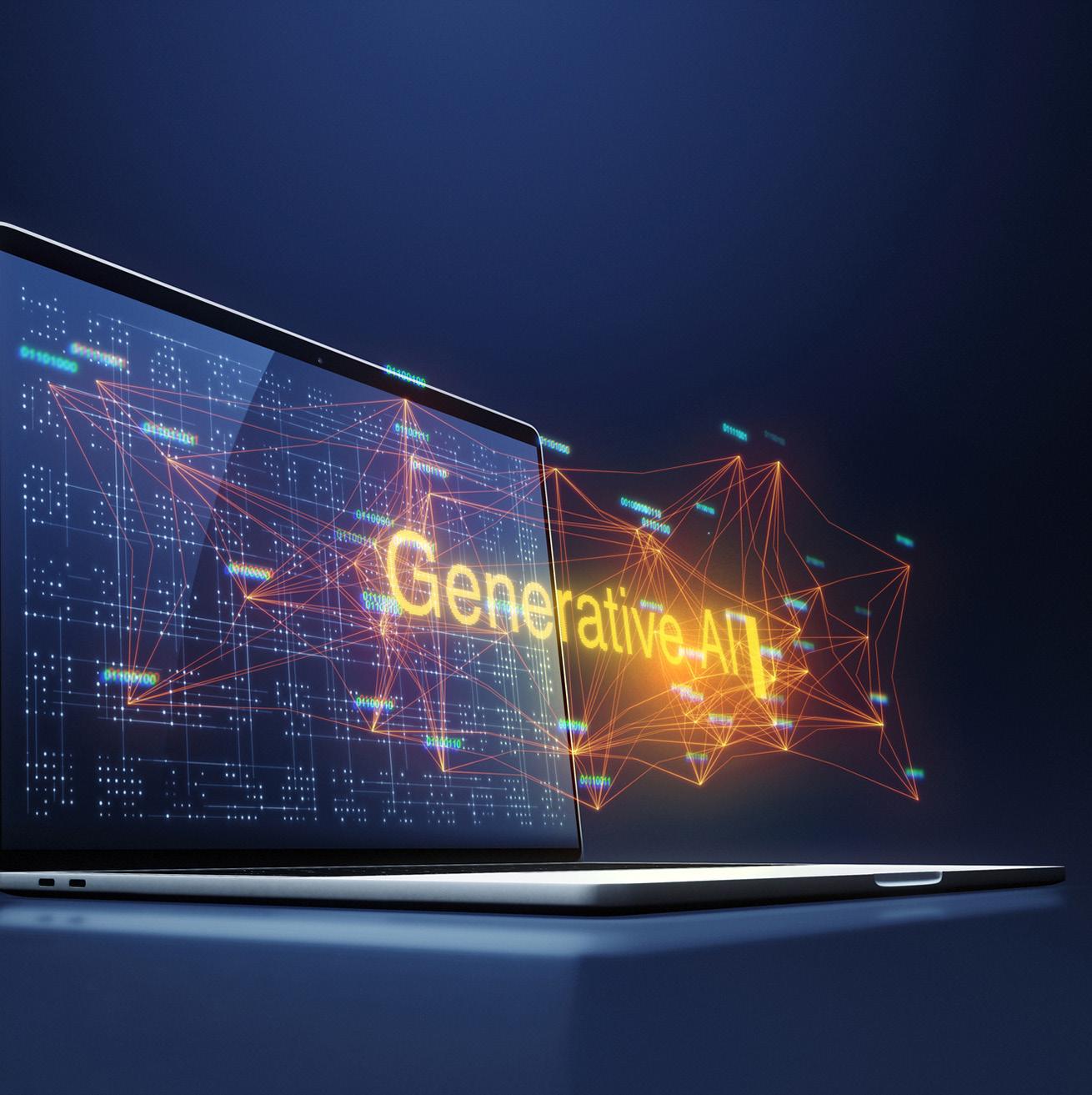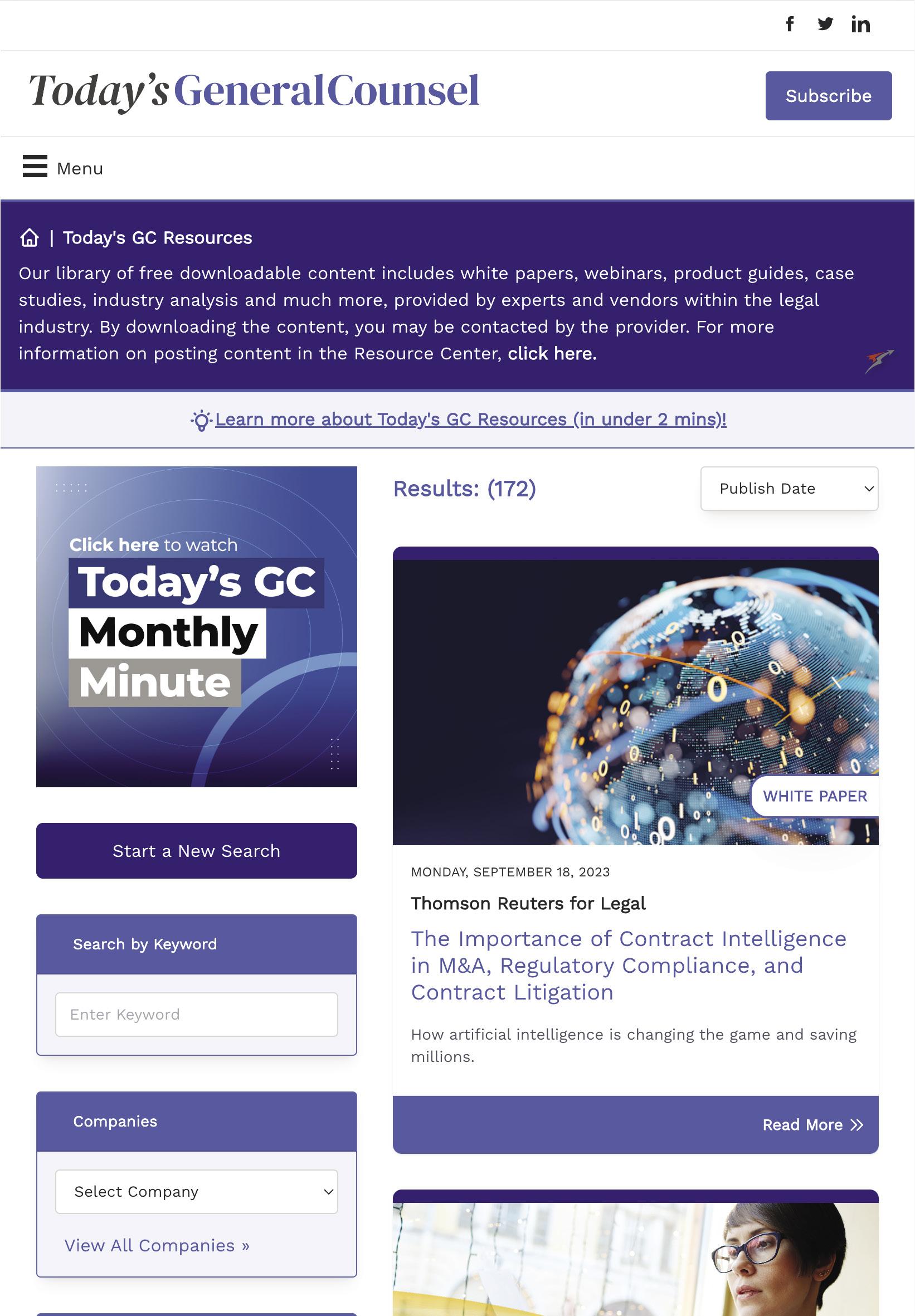




Our panel is composed of accomplished arbitrators and mediators–attorneys, former federal and state judges, and business owners specializing in a diverse range of domestic and international subjects. Each brings a lifetime of experience in fields including healthcare, cyber-security, IP, aerospace, energy and more. When resolving your dispute requires industry expertise, trust the American Arbitration Association®

8 Empowering Lawyers with Generative AI: Exploring the Future of Legal Technology

Using generative AI like a tech-savvy assistant.
Interview with Rawia Ashraf of Thomson Reuters
14 How Has Mass Arbitration Evolved and Where Is It Going?
Effective and economic rule-based processes for arbitrations.
Interview with Neil B. Currie of the American Arbitration Association
Volume 20/Number 7
EDISCOVERY
12 Help! The Case for Outside E-Discovery Counsel
Practicing law where it intersects technology.
By Lianna E. Donovan and Julie A. FlamingLABOR & EMPLOYMENT
20 Florida Employers Need to Use E-Verify Under New Immigration Law
New hires after July 1 must be E-Verified.
By Hector A. Chichoni and Kevin E. VanceCOLUMN/THE ANTITRUST LITIGATOR
22 Ruling Redefines “Rule of Reason” in McDonald’s Antitrust Case
District court reversed on no-poach restrictions.
By Jeffery M. CrossFEATURE
24 How to Negotiate an AI Contract to Maximize Value, Reduce Risk
If your AI processes your PPI
(Protected Personal Info), are you violating privacy laws?
By Curtis Capeling and Wesley McCullochAny doubts that generative AI will be an invaluable tool for legal departments should be put to rest when you read Rawia Ashraf’s interview in this issue of Today’s General Counsel. Ashraf says many things about the uses AI can be put to, and includes a caution: Don’t get caught up in the buzz. Use it to tackle existing problems in a better way.
An agenda of concerns to be addressed when you negotiate an AI contract is the topic of Curtis Capeling and Wesley McCulloch’s article. Potential liabilities and whether your existing insurance has them covered tops their list.
In an interview, Neil B. Currie, Vice President of the American Arbitration Association, discusses mass arbitration, how it is used, the rules that apply, procedures to best resolve cases, and many other aspects of this alternative to litigation. Hector A. Chichoni and Kevin E. Vance write about Florida’s new rules governing the hiring of immigrants.

Jeffery M. Cross’s column addresses no-poach agreements, a big topic in antitrust. The 11th circuit recently reversed a lower court in respect to McDonald’s workers’ right to work for a different franchise.
Bob Nienhouse, Editor-In-Chief bnienhouse@TodaysGC.com
EDITOR-IN-CHIEF
Robert Nienhouse
SENIOR MANAGING EDITOR
Amanda Kaiser EXECUTIVE EDITOR
Bruce Rubenstein
CHIEF OPERATING OFFICER
Stephen Lincoln
DIGITAL EDITOR

Catherine Lindsey Nienhouse
SENIOR EDITOR
Barbara Camm
MANAGING DIRECTOR OF CLIENT PARTNERSHIPS & INITIATIVES
Lainie Geary
WEB EDITOR
Jessica Bajorinas
ART DIRECTION & PHOTO ILLUSTRATION MPower Ideation, LLC
FEATURES EDITOR
Jim Gill
ACCOUNT EXECUTIVE
Stella Valdez
DATABASE MANAGER
Patricia McGuinness
Rawia Ashraf
Curtis Capeling
Hector A. Chichoni
Jeffery M. Cross
Neil B. Currie
Lianna E. Donovan
Julie A. Flaming
Wesley McCulloch
Kevin E. Vance
SUBSCRIPTION
Subscription rate per year: $199
For subscription requests, email subscriptions@todaysgc.com
Dennis Block GREENBERG TRAURIG, LLP

Thomas Brunner WILEY REIN
Peter Bulmer JACKSON LEWIS
Mark A. Carter DINSMORE & SHOHL
James Christie BLAKE CASSELS & GRAYDON
Adam Cohen FTI CONSULTING
Jeffery Cross SMITH, GAMBRELL & RUSSELL, LLP
Thomas Frederick WINSTON & STRAWN
Jamie Gorelick WILMERHALE
Robert Haig KELLEY DRYE & WARREN
Robert Heim DECHERT
Joel Henning
JOEL HENNING & ASSOCIATES
Sheila Hollis DUANE MORRIS
David Katz WACHTELL, LIPTON, ROSEN & KATZ
Steven Kittrell MCGUIREWOODS
Nikiforos latrou WEIRFOULDS
Timothy Malloy MCANDREWS, HELD & MALLOY
Steven Molo MOLOLAMKEN
Thurston Moore
HUNTON & WILLIAMS
Robert Profusek
JONES DAY
Art Rosenbloom
CHARLES RIVER ASSOCIATES
George Ruttinger CROWELL & MORING
Jonathan S. Sack MORVILLO, ABRAMOWITZ, GRAND, IASON & ANELLO, P.C.
Victor Schwartz SHOOK, HARDY & BACON
Jonathan Schiller BOIES, SCHILLER & FLEXNER
Robert Zahler
PILLSBURY WINTHROP SHAW PITTMAN
REPRINTS
For reprint requests, email Lisa Payne: lpayne@mossbergco.com Mossberg & Company Inc.
All rights reserved. No part of this publication may be reproduced or transmitted in any form or by any means, electronic or mechanical, including photocopy, recording, or any information or retrieval system, without the written permission of the publisher. Articles published in Today’s General Counsel are not to be construed as legal or professional advice, nor unless otherwise stated are they necessarily the views of a writer’s firm or its clients.
Today’s General Counsel (ISSN 2326-5000) is published ten times per year by Nienhouse Group Inc., 110 N. Wacker Drive, Suite 2500, Chicago, Illinois 60606. Image source: iStockphoto | Copyright © 2023 Nienhouse Group Inc. Email submissions to editor@todaysgc.com or go to our website www.todaysgeneralcounsel.com for more information.
Those
Rawia Ashraf, Vice President of Legal Practice and Productivity at Thomson Reuters, develops customer-driven legal software that helps attorneys successfully do their jobs with a particular focus on innovative technologies and AI. She is a graduate of Cornell Law School and the University of Maryland, and before joining Thomson Reuters, she practiced antitrust law at Simpson Thacher & Bartlett in New York and DC. Besides her work in the legal industry, she is active with Food Bank for New York City and other nonprofits focusing on women and income inequality.
Today’s General Counsel recently interviewed Ms. Ashraf:

How do you see companies incorporating generative AI capabilities in the next 12 months?

I see a few ways legal technology companies might adopt generative AI. First, there will be some who simply incorporate it for the sake of having it, maybe to boast about having the latest tech or to ride the buzz. But it’ll be interesting to see how that pans out.
The companies that truly succeed with generative AI will be the ones who use it to tackle existing problems in a better way. They’ll ask themselves, “What challenges do our users face? What issues are prevalent in our industry?” Then they’ll figure out how to leverage generative AI to address those problems and close the gap.
So, the key is for product teams, engineering teams, and customer researchers to focus on using this new capability to solve real issues that affect their users. By doing that, they’ll make the most out of generative AI’s potential.
To build off of that, what do you think some of those problems
Rawia Ashraf Vice President of Legal Practice and Productivity at Thomson Reuters rawia.ashraf@thomsonreuters.comare? What would be an example of something generative AI could help with?
Let’s step away from the legal side of things and think about technology on a broader scale. Here’s the thing, most tech users only scratch the surface of what a tool can actually do and probably only use about 10 or 20 percent of its capabilities. Imagine if we could tap into the remaining potential through generative AI. Instead of getting into coding or complex workflows, we could just go for a more user-friendly approach.
Picture this: you’re using an application, and you want it to create
a specific automation workflow. Normally, that might intimidate a lot of people, but with generative AI, you could just command the application through dialogue. You’d say something like, “Hey, create this automation for me,” and boom, the AI would act like a tech-savvy assistant, setting up the workflow for you. I think that could be incredibly powerful.
Microsoft 365 Copilot videos and demos are a great example. They showcase how people can get more out of Excel by simply telling it what they want through generative AI. So, instead of fumbling around trying to create a pivot table, you can just ask Excel to do it for you — which is a game-changer.
The other exciting thing is that generative AI is changing the way we interact with tools altogether. Imagine tossing aside those complicated research queries and just asking your documents questions in plain language. Generative AI could mimic the way we think and work, integrating seamlessly into our technology.
With this in mind, how do you see the legal market evolving in the next 12 months?
So, if we zoom out, I really believe that in a few years—maybe three or four—AI assistants will become commonplace tools for every lawyer. It’s going to be the standard. But in the next 12 to 24 months, we’ll start witnessing this transformation taking shape. We’ll begin experimenting with AI in the legal field to see what works and what doesn’t. Honestly, right now, we don’t have all the answers, and it’s a learning phase for all of us.
And sure, there might be some
parts of the legal market that will mostly stay the same within the next year. They’ll just be starting to test the waters, not wholeheartedly adopting generative AI in their workflows. However, there will likely be specific areas where AI proves useful, and that’s where we’ll focus our efforts and invest more resources. Of course, a lot depends on how well companies tackle the issues related to the accuracy and trustworthiness of AI-generated answers. That trust factor will play a significant role in guiding the legal sector’s adoption of AI technology.
One example of those accuracy issues is that generative AI can hallucinate when producing content, which understandably might make lawyers very nervous. Do you see this skepticism being mitigated by more product evolution or simply by managing expectations?
Both factors are crucial here. Accuracy and correctness are the lifeblood of a lawyer. People seek lawyers’ advice because they want the right answers, and that’s never going to change. It’s essential that the technology keeps improving and narrows the gap with hallucinations while achieving higher levels of accuracy. Of course, it won’t be perfect, just like humans aren’t, but that’s the direction we need to go in.
Now, when it comes to managing expectations, we can’t expect generative AI to outperform human lawyers. It’s essential for users to understand its limitations and how to use it effectively in specific situations. It’s like working with junior colleagues; you don’t blindly accept everything they give you. You review it, check sources, and build trust with their work over time.
I’m optimistic about the progress being made in minimizing inaccuracies and hallucinations with generative AI. The science is advancing rapidly, especially with techniques like retrieval augmented generation and grounding AI in real content rather than relying solely on standard models. We’ve seen significant progress in just the last six months, and I’m excited about what’s to come.
It’s generative, so it’s only going to get better?
The interesting thing about generative AI in my experience is that it’s kind of the ultimate people-pleaser. It’s not giving you a correct answer, it’s trying to give you the answer it thinks you want. And so, as we give it better parameters and better context around what we want, and what we are expecting, it can provide better answers.
In your experience as a former attorney and current product leader, what would you consider to be the secret sauce in building the best legal tech?
Well, I think there are probably a few ingredients in a secret sauce, but I guess number one is really understanding your users. Really putting
A lot depends on how well companies tackle the issues related to the accuracy and trustworthiness of AI-generated answers.
yourself in their shoes and understanding that no one went to law school to chase signatures, organize closing binders, or footnote and format citations. There is a lot of time lawyers and legal professionals spend doing that kind of work. And I think if you’re conscious of helping lawyers practice at the top of their license, that’s critical.
The key is to take out the painful aspects of the legal workflow, so lawyers can focus on what they really went to law school for. It’s like clearing the path for them to do what they do best. But, it’s also important to be realistic and not expect an overnight revolution in how lawyers work. Taking small, incremental steps is the way to go. By understanding the problems they face and working closely with them, solving those smaller issues, and gradually building trust, you can pave the way for adopting new technology and improving the overall workflow. It’s a balanced combination of understanding lawyers’ challenges and adapting technology to fit seamlessly into their ways of working.
Often, the newest and subsequently least qualified attorneys make the first draft of documents, which can trigger rounds and rounds of review. Since you were an associate at one time, can you explain how the technology may have improved your first drafts?
I think this is actually one of those areas where technology can be hugely useful in terms of knowledge management. It’s really interesting how lawyers and organizations often rely on what’s in their minds rather than having everything properly documented. But with AI-based knowledge management solutions
you can easily find the best initial draft. There’s really no need for anyone to start from scratch these days unless it’s a completely new area of law. Even then, it’s smarter to look for something similar and use that as a starting point. The key is to have well-organized templates, precedents, and sample contracts that the company has used before. Juniors can benefit a lot from these resources, tapping into the organization’s experience instead of
content. Those are net new capabilities that we’ve not experienced before in mass-available technology. So that’s the next space. Generative AI can really shorten that process so that you can focus on the next steps as opposed to summarizing what has happened.
So as a final thought then, would you say the key area where AI is going to help is by making processes more efficient, less time-consuming, and less menial instead of attempting to make legal decisions that lawyers would typically make?
reinventing the wheel every time. It just makes the whole process more efficient and effective.
The challenge is that setting up knowledge management assistance takes so much time. That’s where generative AI can make those tasks easier and you don’t have to invest up front time in making those things more accessible.
It’s clear that AI technology is focused on specific tasks like classifying documents or extracting key provisions. What other types of tasks might be favorable to process improvement by AI?
So, we talked about automating workflows and taking the grunt work out of legal is a big one. What’s new and exciting about generative AI is the technology’s ability to draft content, summarize content, and modify
Yes, that’s where I see it first taking hold because it’s less risky to implement. And as organizations get comfortable with it as an assistant, then they can start to upscale how it’s used. But I don’t see it replacing legal judgment. It shouldn’t. Lawyers should be making decisions about those things, and AI should make it easier to have the relevant information and get them to a decision point more quickly.
If you'd like to continue the discussion, please reach out to rawia.ashraf@thomsonreuters.com
The key is to take out the painful aspects of the legal workflow, so lawyers can focus on what they really went to law school for.
UPCOMING
Using ChatGPT to Revolutionize Investigations and Discovery: Understanding the Benefits and Discussing the Risks
TUESDAY, OCTOBER 24
1:00PM ET
We will show you how you can use Large language models (LLMs) for:
• Summarizing and analyzing relevant documents, transcripts and SMS texts.
• Providing answers to complex questions about documents or transcripts.
• Identifying key participants, creating timelines, and summarizing key events.
• Generating comprehensive investigation reports tailored to your objectives.
• Conducting document review, with detailed reasons for classifications.
UPCOMING
The Crossroads of Data Privacy, Cybersecurity, and Compliance: What's At Risk and How To Prepare

TUESDAY, NOVEMBER 7
1:00PM ET
In this webinar, we will discuss these top-of-mind topics and provide strategic insights on:
• Proactive engagement in the face of evolving global data privacy regulation and crossborder business.
• Operationalizing data privacy to position your organization to comply with the growing spider web of US state and global data privacy regulations.
• Integrating AI in data privacy and cyber incident response.
• Data management and information governance, including defensible disposition.
UPCOMING
AI & Ethics: New Developments, Regulatory Considerations & Ethical Obligations

THURSDAY, NOVEMBER 16
1:00PM ET
Register for this CLE eligible event to learn about:
• Articulating clear ethical principles and compliance requirements for AI development and deployment,
• The practical implementation of ethical and regulatory requirements to the demonstration of accountability and transparency in AI governance,
• Understanding of the compliance trifecta approach and how to apply it to AI governance, and
• To be equipped with practical tips and strategies for managing ethical, regulatory, and legal risks associated with AI development and deployment, and for fostering a culture of responsible AI innovation.
 By LIANNA E. DONOVAN AND JULIE A. FLAMING
By LIANNA E. DONOVAN AND JULIE A. FLAMING
As corporate legal departments evaluate ways to streamline operations and gain efficiencies, companies may be hesitant to add outside e-discovery counsel to a litigation or regulatory matter’s legal team. They wonder what lawyers who specialize in e-discovery can provide that in-house legal departments, other outside counsel and e-discovery vendors cannot.
While needs will vary across
clients and matters, engaging outside e-discovery counsel for their skill and experience navigating e-discovery issues can be worth it, and increasingly it can be critical. Outside e-discovery counsel can ensure the company fulfills its legal obligations in discovery and remains best positioned for a favorable result.
Just about every legal matter today will involve discovery of electronically stored information. This is nothing new; email and other forms
of ESI have been discoverable data sources since the Federal Rules of Civil Procedure were amended in 2015. Most attorneys, including in-house and outside counsel who aren’t focused on e-discovery, now have at least a basic understanding of concepts such as search terms and metadata.
Outside e-discovery counsel’s expertise lies at the intersection of law and technology. They understand the client’s legal rights and
duties, both broadly and in the context of a particular matter, while also understanding the complex electronic systems that create and store the client’s data, and the array of technologies that make it possible to collect, search, review and produce that data efficiently and effectively.
As data grows in volume and complexity, this multifaceted understanding is a necessity to avoid spoliation and other sanctionable
increasingly called upon to weigh in on e-discovery disputes, outside e-discovery counsel are best positioned to assess technological processes and information and use it to advocate on their clients’ behalf.
Outside e-discovery counsel’s expertise can be leveraged before and after the document collection, review and production phase. They are skilled at advising clients on information governance issues before disputes arise, drafting legal
data sources while taking strategy, cost and legal considerations into account.
As ESI continues to grow, so will the issues surrounding its preservation, collection, review and production. Outside e-discovery counsel possess both the legal and technological expertise to address these issues and, along with their in-house and other outside counsel colleagues, fill a critical spot in a litigation or regulatory matter’s legal team.
conduct; safeguard the client’s trade secrets, sensitive business information and other valuable intangible assets; and control overall discovery spend. After all, a lawyer cannot certify that a document production is reasonable or recommend strategies for narrowing the universe of data for collection and review without understanding the capabilities and limitations of the systems where that data lives.
While IT professionals and e-discovery vendors can assist with some technical aspects of document collection, review and production, over-reliance on those parties can bring significant risks, including inadvertent disclosure of privileged or confidential information. Outside e-discovery counsel are qualified to evaluate e-discovery vendors and tools, and recommend those best suited to a client’s needs. They also know how to effectively supervise technologists, and can bridge the gap among technologists, other counsel and the court. As judges are
holds and performing early case assessments at the outset of a matter, negotiating e-discovery parameters, developing ESI protocols and protective orders at the meet-and-confer stage, and assisting with deposition preparation. Delegating these tasks to outside e-discovery counsel allows in-house and other outside counsel to focus on the merits of the case, including fact investigation, development of legal theories and strategies, and settlement efforts.
Additionally, with new and constantly evolving sources of ESI — like SaaS collaboration applications such as Asana and Salesforce, messaging platforms such as Microsoft Teams and Slack, and even emojis — it isn’t realistic to expect all lawyers to be well-versed in substantive legal areas as well as the complexities of developing data sources and related e-discovery technologies, workflows and case law. Outside e-discovery counsel are focused on these issues, and can advise companies on how to handle emerging and complicated
Lianna E. Donovan is a partner at Nelson Mullins. She practices in the areas of electronic discovery, records and information governance, cybersecurity and data privacy, and business litigation. She advises clients on document preservation issues, including the development and implementation of defensible records retention and data disposal programs.

Julie A. Flaming is a partner at Nelson Mullins. She practices in the areas of electronic discovery and litigation readiness, pharmaceutical and medical device litigation, product liability, and business litigation. She has substantive knowledge of issues related to electronic discovery as well as document collection, review, and production.

A lawyer cannot certify that a document production is reasonable without understanding the capabilities and limitations of the systems where that data lives.

Neil B. Currie is a Vice President of the American Arbitration Association. Mr. Currie currently oversees the AAA’s Consumer Division and SelfRepresented Case Administration Team.

Tell us about the AAA and the services it provides.
The American Arbitration Association (AAA) is the largest private global provider of alternative dispute resolution (ADR) services in the world. It is a not-for-profit organization founded in 1926. It is dedicated to the fair, effective and economical methods of dispute resolution through education, technology and solutions-oriented service. The AAA provides a variety of dispute resolution processes. The most common
ones that people are familiar with are arbitration and mediation.
We provide these services to a wide range of user communities including commercial, employment, international, labor, consumer and construction. We also provide dispute resolution programs for states, such as the New York State no-fault insurance program and the Minnesota no-fault arbitration program. And we have provided services for communities that are impacted by natural disasters, including the North Carolina Disaster Mediation Program and the Superstorm Sandy Mediation programs in New York and New Jersey.
The AAA has been a leader in the development of due process fairness standards for a variety of types of disputes and fields, including the
Neil B. Currie Vice President of the American Arbitration Associationconsumer due process protocol, the employment due process protocol and the healthcare due process protocol. The goal of these protocols is to ensure fairness and evenhandedness in the resolution of disputes when used in concert with the AAA’s arbitration rules. We have a roster of arbitrators and mediators composed of distinguished former judges and leaders in the legal and business communities who have industry-specific knowledge and expertise. Arbitrators and mediators on AAA panels are not employees but instead are independent contractors for the parties. We hold them to strict principles of integrity, conflict management service, diversity and inclusion.
The AAA has a long history of administering large-scale individual cases. They include insurance-related disputes, disputes arising from financial crises like the Great Recession as well as cases related to asbestos-related personal injuries. Mass arbitration has emerged as a way of resolving a large number of individual claims. The AAA defines mass arbitration as arbitrations with 25 or more similar demands for arbitration. They are filed against or on behalf of the same party or related parties, with the representation for those parties consistent or coordinated across all of the cases. The AAA’s Mass Arbitration rules will apply when our definition of mass arbitration is met and either the AAA’s employment and workplace fee schedule or the consumer fee
class of potential claimants. The key difference between mass arbitration and class arbitration is that in mass arbitration the claimants all separately file demands for arbitration. Each claimant is named individually and is assigned to a separate Merits Arbitrator. It is these arbitrators who decide the ultimate merits of the case before them between that claimant and the specific respondent. Cases that proceed to the Merits Arbitrators are decided individually. There is a separate decision, or award, for each case from the
past couple of years. These rules signify the AAA’s commitment to addressing the unique challenges and complexities associated with these cases and demonstrates our dedication to staying current and adapting to the ever-changing landscape.
schedule applies to the arbitrations, or by party agreement.
What is the relationship between class arbitration and mass arbitration, and how do they differ?
They are different in practice for the AAA. In class arbitration, similar to class litigation, the claimants are known as a class, which includes all the people potentially impacted by the issue. They are not individually named, however. The claim is filed by one or more parties or a representative on behalf of the larger group. A single arbitrator decides the matters that affect that entire
Merits Arbitrator based specifically on the laws and the facts of that case. Mass arbitration claims are administered under a separate set of AAA rules, the Mass Arbitration Supplementary Rules.
What are the Mass Arbitration Supplementary Rules? Tell us more about them and how they work. We felt that we needed a rule set to address the unique aspects of these cases. And we wanted to create a process that would be workable and beneficial to all involved. As a result, Mass Arbitration Supplementary Rules were implemented over the
Let me explain how supplementary rules function in conjunction with the base rule set. For most of our history, the AAA has developed rules to govern disputes. Probably the ones that are most well-known are our Commercial Arbitration Rules, which generally address business-to-business disputes. AAA Rules set forth the rules of the AAA’s arbitration process, starting with filing the case, then to the initial interactions with the AAA, and on to appointing an arbitrator. There are the pre-hearing steps — the exchange of information and a preliminary hearing — that determine when things are going to happen. The process continues through the award and what happens after the award. That is how most of the AAA arbitrations are constructed.
The Supplementary Rules supplement one of these base rule sets, addressing the unique aspects of mass arbitration and providing effective administration tools so that the numerous cases proceeding at the same time can move through efficiently, effectively and economically for everyone from start to finish. They provide specific mass
The American Arbitration Association (AAA) is the largest private global provider of alternative dispute resolution (ADR) services in the world.
We are dedicated to the fair, effective and economical methods of dispute resolution through education, technology and solutions-oriented service.
arbitration features that address any unique challenges the parties might have. Sometimes there are specific steps the parties want to take. This is allowed under the Supplementary Rules. The cases are all different, and the rules are flexible enough to allow the parties to customize them so that they can make agreements that address their specific needs.
One thing I’d like to point out that is very innovative in terms of our mass arbitration rules is that we developed a position called the Process Arbitrator. It was created to address party disputes about the administrative process of the arbitration, such as which rules would apply if there’s a dispute between the parties over whether the commercial or consumer rules apply. Those sorts of arguments can be addressed early on by the Process Arbitrator, and their decision would be applicable to all the cases from that point forward. This would allow the parties to proceed in a more efficient manner. The underlying substantive disputes could move through the arbitration process, and a Merits Arbitrator would be appointed to each individual case to provide a final determination.
Are there any other efficiencies, such as special processes, that parties use to resolve mass arbitration and what are they?
Absolutely. Based on our extensive experience in assisting parties with large dispute resolution processes, we not only develop effective and economic rule-based processes for these arbitrations, we also work with parties to develop unique procedures customized to best resolve their cases. Here are some examples of these additional procedures.
• Agreed-upon scheduling order. This allows the parties to set deadlines for various things such as submission of documents, witness lists, or when the discovery should be completed or motions should be filed. Parties can agree to a scheduling order that applies to each case across the board. The benefits are that it may limit the number of preliminary hearings needed and can be a significant money saver.
• Use of a Special Master. That’s another type of dispute resolution professional who can oversee issues common to the case such as discovery, choice of law or whether there are statute of limitations arguments. The Special Master is someone the parties can use outside of their Merits Arbitrator to make decisions that are impactful to all the cases that proceed.
• Agreement to hear cases just on documents. With this procedure, you present your arguments per your materials and your evidence to an arbitrator just on papers or documents. Economically, this cuts through the time it takes to schedule and hold a hearing.
• Assigning multiple cases to a single arbitrator. Agreeing to assign multiple cases to one arbitrator makes scheduling much easier and the hearings much more efficient. Even though the individual arbitrator will still decide each case individually, that arbitrator will have a lot of knowledge and expertise in working with the parties and can be extremely efficient in deciding multiple cases on an individual basis.
• Agreeing to an award form. The parties can say that they want the
award in a specific format, and all of the Merit Arbitrators would follow that format. Not only would this simplify the process for all of the arbitrators, it can be a time saver. It could also limit briefing motion and discovery requests, which normally take up a lot of time.
• Considering agreements on testimonies. The parties also may want to consider agreements on testimonies, which would allow an affidavit or a recorded deposition instead of live witness testimony.
• Expanding the role of Process Arbitrator. Sometimes parties decide to expand the role of the Process Arbitrator. They find that as they work with the Process Arbitrator, they have established a rapport, the Process Arbitrator having gained their trust and demonstrated that they thoroughly understand the case. Sometimes the parties will turn issues over to that Process Arbitrator and say, “Hey, we are having trouble scheduling.” Or “We’re having trouble coming up with a good process to appoint our Merits Arbitrator. Could you help us with that?” Or “Could you give us a decision on what is the best process on how to facilitate the type of hearings that are going to take place?”
• Considering use of mediation. From our experience, a mediator is a very important part of the mass arbitration process. When parties use a qualified mediator to engage in a global mediation process, we’ve found a high rate of settlements for mass arbitrations. We have many qualified mediators with experience in large-scale disputes who can assist the parties,
whether at the outset of the filing or during the middle of the case. Not only can the mediator, hopefully, resolve the case on a global scale, but if they can’t resolve it, they can assist the parties in narrowing down their issues.
• Collaboration. Ultimately, what we found to be the most effective has been the parties’ representatives working in collaboration with an experienced administrator from the AAA to curate dispute resolution processes that fit the needs of the parties and the specific cases.
Is technology playing a different role in mass arbitration than it has in the past?
Technology has been a real benefit to mass arbitration. It has allowed us to create processes that have improved the administration of these cases. Our technology systems have provided efficiencies that make managing the cases easier and more cost-effective for everyone. For example, we have a different filing fee for mass arbitrations that is lower than the filing fees for our core cases because we were able to create efficiencies in the intake process.
An important technological component emerging from the pandemic has been the use of video conferencing, which has exploded in the ADR world. It makes it much easier to schedule, handle cases and work with people all over the country. On another level, we have secure portals for parties and arbitrators to manage their cases and best practice protections against both external and internal cyber threats. We have invested in technology to help protect all case data stored and managed on our technological infrastructure,
and maintain the highest caliber of data privacy protection.
Twenty years ago, it might have been a lot harder to do some of the things we’re trying to do today. We’re always creating new technological enhancements and rolling out new tools. And we’re engaged in ongoing discussions and review of AI, about what it can do related to dispute resolution.
Tell us about the arbitrators who handle the disputes. The roster of all arbitrators available to be appointed to an AAA case generally is described as a “panel.” And
its own merits. Such a process could be a more efficient way to appoint arbitrators to cases if the parties are interested and can agree.
As with all cases at the AAA, the Merits Arbitrators serving on these cases have expertise in the underlying subject matter of the disputes. Our mass arbitration arbitrators consist of accomplished attorneys with subject matter expertise, as well as former federal and state judges. They understand the intricacies and the variance of the cases and the industries they’re involved with. For the arbitrators who join our panels, the AAA provides state-of-the-art
in the context of mass arbitration, specifically, it would be all those arbitrators the AAA has identified who are available to be appointed to a mass arbitration case. An option the parties might consider agreeing to use is a concept that we call a “rotating panel of arbitrators” to decide the cases in a mass arbitration. This would require the parties to agree to a specific number of arbitrators, say 20-30 arbitrators, and then cases would be assigned individually to each of these arbitrators until all of them have been assigned a case, at which time the process starts again with this same group of arbitrators being assigned an additional case. In the end, an arbitrator would be assigned to multiple individual cases, each to be decided on
dispute resolution training as well as ongoing training to focus them on managing the process with fairness and skill. The AAA also provides specialized training for unique aspects of the mass arbitration process.
We’re very committed to provide the parties with a diverse roster of arbitrators and mediators. For the two most common areas of mass arbitration, employment and consumer, the AAA has a roster available on the employment side that as of June 2023, is 48% diverse; and on the consumer side, one that is 38% diverse. These figures continue to increase with the AAA’s ongoing efforts. Earlier this year, we signed onto the Ray Corollary Initiative Pledge for Alternative Dispute Resolution Providers, which is an
We have a roster of arbitrators and mediators composed of distinguished former judges and leaders in the legal and business communities with industryspecific knowledge and expertise.
Class arbitration. One or more of the parties or a representative, files a claim on behalf of the larger group, which is called a class. The claimants are not individually named. An arbitrator decides matters that affect that entire class of potential claimants.
Mass arbitration. The claimants all file separately, and each claimant is named individually. Each case is assigned to a Merits Arbitrator and is decided individually.
industry-wide effort to increase the number of women and racially and ethnically diverse ADR professionals who serve as arbitrators, mediators and other dispute resolution neutrals.
Something else that sets the AAA apart is that we have the size and reach for both our national and international panels. Obviously, most of the mass arbitrations we’re talking about are domestically based. We have a panel that stretches from coast to coast, north to south. We also have a robust international panel should a mass arbitration-related matter arise that has an international component.
Finally, and probably most importantly, our panelists are committed to serving pursuant to high, stringent standards of ethics and integrity. All panelists serving on these arbitrations must commit to the Code of Ethics for Arbitrators in Commercial Disputes, which is the industry standard. We also ask the panelists to commit to additional standards, the Standards of Responsibility, established by the AAA. The AAA takes all of these commitments very seriously. We expect arbitrators to comply with these requirements when they’re serving on our AAA roster. If there are any issues, we address
them directly with the panelists in the case, and then we monitor that issue moving forward.
Do you seek out the arbitrators or do they come to you?
We have a wide range of vice presidents who oversee our panels throughout the United States and internationally and recruit for various industries and various sections of the country and around the world, depending on what is needed. The vice presidents who oversee these panels recruit arbitrators based on the needs of the AAA and their local areas. We do have people who approach the AAA if they’re interested in serving as a dispute resolution provider as well, but our standards are quite high. We’re obviously very discerning about who we bring onto a panel.
What is one thing that you would like to emphasize that is unique about the AAA?
Given our size and experience with large-scale group cases, it is unlikely that any other ADR provider could handle our large mass arbitration caseloads. Whether it’s a financial or natural disaster, we are able to use our experience, our staffing, our technology and our
panelists to resolve claims efficiently in extremely trying circumstances. This is part of our history and unique to the AAA. We have vast national and international arbitration panels that we can deploy to handle such largescale disputes. We know what to do and how to interact with the parties involved. As the industry leader, we are in a good position as we move forward and as mass arbitrations continue to develop and change.
Since the founding of the AAA, we’ve tried to adapt and move forward to address what is taking place in the field of ADR, which was relatively new when the company began. Arbitration, mediation and dispute resolution, for example, have significantly expanded. The great thing about alternative dispute resolution at the AAA is that we can provide flexibility when developments such as mass arbitration arise. Mass arbitration itself is a flexible process. It is a process that works best when the parties are collaborative, when they’re not trying to bring a litigation mindset into it to try to fight every aspect. If the process is going to work well for all sides, we think it’s best that the parties work with the AAA and with opposing counsel to come to some agreements about what is going to meet their needs. This normally ends up with better outcomes, along with cost savings and greater satisfaction for all parties.
Webinars


 By HECTOR A. CHICHONI AND KEVIN E. VANCE
By HECTOR A. CHICHONI AND KEVIN E. VANCE
On May 10, 2023, Gov. Ron DeSantis signed SB 1718 into law, dubbing it the “Strongest Anti-Illegal Immigration Legislation in the Country to Combat Biden’s Border Crisis.” The centerpiece of the law, however, is a provision requiring private-sector employers with at least 25 employees to use the E-Verify system to verify the employment eligibility of new employees. This requirement went into effect on July 1, 2023.
E-Verify is an internet-based system that compares information found on the employer’s Form I-9 Employment Eligibility Verification to records available to the U.S.
Department of Homeland Security, Social Security Administration and recently, the U.S. Department of State, to confirm that the individuals hired are authorized to work in the United States.
Significantly, the mandatory E-Verify provision will apply only to new hires made on or after July 1, 2023. Employers are not required to use E-Verify with respect to employees hired before that date. Also, the law does not cover independent contractors.
If an employer is unable to verify a newly hired employee because the E-Verify system is unavailable for more than three business days
after the new hire begins work, the employer will be required to (i) use Employment Eligibility Verification Form I-9 to verify employment eligibility, and (ii) retain a screenshot or other proof of the system’s unavailability for each day the employer was unable to access the system.
Under the new law, employers must retain a copy of the documentation provided and any official verification generated for at least three years. It appears for now that the new law, based on present federal regulations, intends the document retention requirement to be triggered by the date of employment. Federal I-9 rules already require
that an employer must retain a Form I-9 for each person hired for “three years after the date of hire, or one year after the date employment ends, whichever is later.”
Beginning July 1, 2024, if an employer fails to use E-Verify, the Florida Department of Economic Opportunity must notify the employer and give them 30 days to

use it. A $1,000 a day fine may be imposed if the employer fails to use E-Verify three times in any 24-month period until the employer provides proof that the noncompliance is cured. Noncompliance constitutes grounds for suspension of all licenses until it is cured.
In addition, the law makes it unlawful for “any person to knowingly employ, hire, recruit, or refer, either for herself or himself or on behalf of another, for private or public employment within this the state, an alien who is not duly authorized to work by the immigration laws of the United States.” It provides penalties for civil employers who violate these provisions.
The law also provides criminal penalties (third-degree felony) for a person who “knowingly uses a false identification document or who fraudulently uses an identification document of another person for the purpose of obtaining employment” and who is “not duly authorized to work by the immigration laws of the United States, the Attorney General
the United States, or the United States.”
Employers required to use the E-Verify system will also be required to certify their compliance on their first return each calendar year to the state’s tax service provider.
Using E-Verify in Florida may have negative effects on hiring in certain industries. Moreover, the Florida Policy Institute has estimated that the new law could cost Florida’s economy $12.6 billion in one
Tuesday, October 17
1:00PM ET
year, which would have widespread impacts throughout the state.
Covered employers should immediately begin preparing to use E-Verify. Questions about what the Law requires and how to comply should be directed to employment and immigration lawyers knowledgeable in E-Verify.
Hector A. Chichoni practices U.S. and global immigration law and is the chair of the firm’s Immigration Practice in Florida. He represents corporate and individual clients, handles international matters and business transactions, and has represented clients in a wide variety of cases before the U.S. Immigration Court. hachichoni@duanemorris.com
Kevin E. Vance is managing partner of the Duane Morris’ Boca Raton office. He represents businesses in litigation matters, including those involving employees. kevance@duanemorris.com

Learn how to arm yourself with deal terms and claims data to inform deal negotiations and streamline due diligence when evaluating your next target.
The SRS Acquiom and Today’s General Counsel webinar will include:
• Tips to avoid post closing claims
• Maximizing data to tailor due diligence efforts
• Exclusive deal insights pulled from over 7,400 deals

Employers must retain a copy of the documentation provided and any official verification generated for at least three years.
 By JEFFERY M. CROSS
By JEFFERY M. CROSS
No-poach agreements are a hot topic in antitrust. Both government agencies and private plaintiffs have challenged such agreements.
Recently the Seventh Circuit weighed in on McDonald’s no-poach agreements. In an opinion by Judge Frank Easterbrook, the court addressed issues regarding the per se rule and the ancillary restraints doctrine that are worth examining.
Under the McDonald’s agreements, each franchisee promised
not to hire any person employed by another franchisee, or by McDonald’s itself, until six months after the last employment date. Another clause barred any franchisee from soliciting another franchisee’s employees. Two former McDonald’s employees sued, alleging that the provisions violated Section 1 of the Sherman Act.
The district court entered judgment of the pleadings, dismissing the complaints. The court rejected the per se approach. It concluded
that the agreements were not naked restraints but ancillary to an effort to expand the output of burgers and fries.
The district court also rejected the Rule of Reason. The complaints had not alleged market power in the labor market, and it held that market power was an essential element of any claim under the Rule of Reason. Absence of such an allegation rendered the complaints implausible.
The Seventh Circuit affirmed the district court’s rejection of the Rule
of Reason. It noted that a relevant market of “workers at McDonald’s” was not sound. People who work at a McDonald’s one week could work at a Wendy’s the next. The court stated that “[t]he mobility of workers . . . makes it impossible to treat employees at a single chain as a market.”
The Court of Appeals, however, held that the district court was too hasty in rejecting the per se rule. The court noted that the agreements were horizontal restraints to restrict the cost of an input — labor. In other words, a conspiracy to achieve a labor market monoposony.
What is the ancillary restraints doctrine? It was first established by Judge William Howard Taft in 1898 in the seminal Addyston Pipe decision. It is a form of the Rule of Reason. If a restraint is ancillary and necessary to an otherwise procompetitive endeavor, it may be lawful. In addition, the doctrine requires that the restraint be reasonably necessary to
answered on a motion for judgment on the pleadings.
Judge Easterbrook’s opinion seems to clash with settled principles regarding the Rule of Reason and the per se rule. It is wellestablished that the Rule of Reason is the presumptive standard. The per se rule is applied only where the restraint is a naked restraint in that there are no plausible procompetitive justifications. In other words, a court can say with confidence that the restraint will always or almost always tend to restrict competition and decrease output. Conversely, if the restraint is designed to increase economic efficiency and render markets more, rather than less competitive, the fuller analysis of the Rule of Reason must apply.
It is also well-established that a trial court must engage in some analysis whether there are plausible procompetitive benefits to determine whether to apply the Rule of Reason or the per se rule. The Supreme Court has rejected a “literal” or “structural analysis” where the per se rule applies merely if the restraint fits into one of the traditional per se categories and it is horizontal.
whether the no-poach agreements were ancillary and necessary to that procompetitive effort, were too complicated on such a motion.
But there could be unintended consequences of this decision. Under the per se rule, procompetitive justifications are usually not considered.
Judge Ripple’s concurring opinion offers some help. Judge Ripple makes clear that the ancillary restraints doctrine, as well as other procompetitive justifications, may be considered on remand. It is almost a Rule of Reason case in disguise.
achieve the procompetitive purpose of the collaboration and is not more restrictive than necessary.
The Court of Appeals held that the ancillary restraints doctrine is a defense that need not be anticipated in a complaint. Furthermore, the court questioned whether the no-poach clauses were ancillary to an effort to increase labor output, and whether they were more restrictive than necessary. The court held that these questions could not be
Significantly, Judge Easterbrook’s opinion sets forth procompetitive benefits of such clauses.
Why therefore did the court reverse the district court’s determination that the per se rule doesn’t apply. Judge Easterbrook’s opinion appears to be holding that there are limits to the analysis that a trial court can engage in to determine whether to apply the per se rule or the Rule of Reason on a motion for judgment of the pleadings. Judge Easterbrook concluded that whether the franchises increased labor output, and

“The mobility of workers … makes it impossible to treat employees at a single chain as a market.”
Your company needs AI. To spot business and legal issues related to AI: learn how it works, what data it uses for training and production, and what it will do for you.
Consider the following when you negotiate for AI services:
What decisions will AI help you make? If a decision is wrong or biased, what liability might result?
Will AI integrate with your products or services and affect your products liability exposure?

Errors in AI output may not be apparent, and problems can compound quickly.
Training and production data that under-represents a gender or ethnicity or that is otherwise prejudiced can cause AI bias. Allocate the risk of AI errors, bias and products liability between you and your vendor. Define the outcomes you expect
from AI, and tailor warranties and remedies accordingly. Nuanced risk allocation may be necessary.
Are your insurance types and limits adequate for the perceived risks?
Who will provide and own the AI training data? Who will conduct the training? What production data will you use when operating AI?
Will AI aggregate your data with
data of others? Should you de-identify the data? What limits should apply to disclosure and use of your data?
AI improves as it processes information, but consider whether competitors and third parties also use the AI, and may benefit from your (or your customers’) confidential information.
If AI processes personal, healthcare, financial or other sensitive information, how will you and your
agreement. Consider what laws to require your vendor to satisfy.
More AI law is coming. Consider whether AI use is (or may become) restricted or prohibited. Some laws may prohibit automated tools in hiring decisions, mandate audits for bias, or require explanation of AI decisions; agencies will promulgate AI rules in regulated industries; the EU Artificial Intelligence Act may ban certain AI uses. What termination rights and economic remedies
the training, operation and output of AI. Typical risk allocation and exceptions to IP indemnity may not be appropriate because using AI and your data can result in modifications, combinations, and evolution.
What are the typical SaaS, software, and technology service issues that should be negotiated in your agreement?
Consider adopting AI risk management policies. Train personnel to use AI only when appropriate, not share sensitive information without adequate protection, and avoid inadvertently subjecting you to an online contract.
AI vendor comply with current and pending privacy law? This includes any duty to delete or account for use and disclosure of personal information.
Know whether AI will transmit your data cross-border. Does the data use comply with applicable law and any requirements of the data source? Do you have the right to permit the expected use? Are notices to individuals required under privacy law, and do you need a data protection addendum, business associate agreement, or similar arrangement? Consider the consequences of an unauthorized use or disclosure, and allocate duties to protect information.
Decisions supported or made by AI must comply with any laws applicable to your company. Determine any compliance risks inherent in AI — especially in highly regulated industries like healthcare and financial services — and allocate compliance duties in your
might you need if new law impairs or prohibits future use?
What IP and proprietary rights do you expect to own or grant in data, AI output, and (if the AI is not static) AI evolutions? Make sure to allocate those rights in your agreement. If you grant rights to data or AI output, consider whether you have adequate rights to do so.
Generative AI produces works, from text and images to audio and source code. Generally, an individual must create the work for IP rights to exist. Works generated entirely by AI likely do not meet that requirement. If your business exploits IP, consider this challenge.
Your AI vendor may not always have clear rights to training data. AI output can be derivative of training data and your use of AI or its output may violate a data owner’s IP and other rights.
Allocate infringement risk for
Considering these issues as you adopt AI will help make the most of this emerging technology and help manage your company’s risk.
Curtis Capeling is a member at Bass, Berry & Sims in its Nashville, Tennessee office. He focuses on helping clients protect and strategically commercialize their intellectual property assets and rights, including representing vendors and consumers of AI services. CCapeling@bassberry.com
Wesley McCulloch is an associate at Bass, Berry & Sims in its Nashville, Tennessee office. He advises companies on data privacy and security matters and counsels clients on compliance with international, national and state privacy laws, including the impact of AI. McCulloch@bassberry.com


Agencies will promulgate AI rules in regulated industries, and the EU Artificial Intelligence Act may ban certain AI uses.